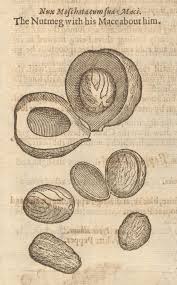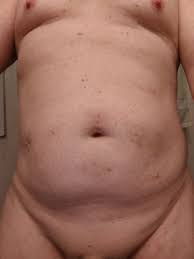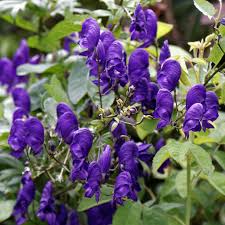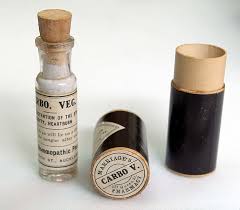
By Edmund Carleton, M.D., New York City
In some unremembered publication, it is impossible to say when or where, I have read how the ape indulges his natural fondness for nutmeg; falls into profound sleep in consequence; and then is captured by wily man. The nurse of yore was accustomed to offer panada, generously spiced with nutmeg, to the puerperal woman. The multipara, suffering with after pains, felt much better after eating the panada. My first study of the provings of Nux moschata upon the healthy impressed me with the ability of the nut to produce great sleepiness and long sleep; a dry tongue which will stick to the roof of the mouth; a cool skin and disturbance of the emotional and sexual spheres, especially in women. My constitution is such that the foregoing outlines come instantly to view, when Nux moschata or the corresponding clinical problem is presented. Study and clinical experience are adding to this picture; but the original sketch of it, given above, was engraved upon my memory.
I hold in my hand the monograph of Nux moschata compiled by Hering with the assistance of his Philadelphia colleagues. It is rare. I only obtained it through the kindness of Dr. T.L. Bradford. It summarizess the life work of Dr. C. E. Helbig and his contributing associates. Of Nux moschata Hering says: “There is not another drug in our materia medica as fully and as comprehensively treats.” The symptoms considered characteristic are indicated by finger points. They are: White coated tongue. Dry mouth and throat. Bad smell from mouth. While eating, soon satisfied. Bearing down in the belly. Soft stool expelled with difficulty. Burning in the urethra when passing water. Menorrhagia; blood thick, dark with such as have had catamenia very irregularly. Pain in sacrum when riding in a carriage. Lassitude from the least exertion. Disposition to faint. Drowsiness. Complaints orginating from cold especially wet cold. Pains and febrile symptoms alleviated by external warmth. Cool, dry skin but sensitive to the air. All the parts on which one lies ache as if sore.
What delights me is the marking of highest value affixed by Boenninghausen to some symptoms to properly emphasize them. Among the symptoms thus distinguished are drowsiness, sleepiness and great sleep. All the symptoms thus marked by Boenninghausen are faithfully recorded in the Guiding Symptoms with which you are familiar.
Hahnemmann said: “Nux moschata is one of the greatest polychrests (at least here in Paris), and is second to none except to Sulphur.”
One purpose of this brief paper is to stimulate the presentation here, to-night, of clinical experiences with this medicine at the hands of scareful prescribers, which shall bring out prominently and verify some of the characteristic symptoms of Nux moschata. Who has not seen great results from this medicine in the treatment of apoplexy, catalepsy, delirium, mania, weak memory, diseases of the nervous system, fainting, exaggerated emotions, typhoid fever, ulceration of the umbilicus and mubilical hernia; in disorders of inenstruation, pregnancy and lactation; in gout and rheumatism, all accompanied with great sleepiness? Tell us the characteristic indications for the remedy in each case. That we may have sufficient time for your valuable contributions my own clinical illustration shall be restricted to one case, and allow me to preface it with the truism that, provided he has “taken” the case as Hahnemann directed, the physician is not to be adjudged guilty of making selection of the remedy upon insufficient evidence, though in that work he has credited one grand characteristic with being relatively more important than many common symptoms.
The patient alluded to was a young lady in literary pursuits. Her nerves had given out in consequence of continued hard work and worriment. The malady had successfully defied the efforts of an eminent specialist, who gave no allegiance to the law of cure. The patient slept most of the time. It was a heavy sleep, from which she was not easily awakened, but presented no other unusual features. When she awoke her eyes were dry, and she said that her “tongue was so dry that it stuck to the roof of her mouth.” She felt exhausted and would not arise from the bed. The skin was day and cool. The abdomen was distended but not sore. There was no fever. There were flatulence and loose stools. Menstruation was late and scanty.
My attention was immediately directed to nutmeg. All the symptoms which have been mentioned were found to have been produced in healthy persons by it. I gave Nux moschata in the two hundredth centesimal potency, to the sick person, and she was cured by it safely, speedily and easily.
Another purpose of this paper is to get your counsel in the following matter: The sleeping sickness is depopulating large districts in Africa, and constantly enlarging its field of operations, as you know. It was formerly supposed to afflict the Negro only, but now, to his dismay, the white man finds him not immune it demands the life of its victim, and will not relent. It is said to be caused by a parasite, the Trypanosoma gambiense, which is conveyed it no the human system by the sting of the tsetse fly, Glossina palpalis. Koch is on the ground investigating the etiology of the disease. May success attend those endeavors? We want to know the disease and its cause and what to avoid. If Koch will work along that line and leave curative measures to those who understand the science of therapeutics we will applaud him.
Quain describes the disease as follows:
“Anatomical Characters. – Manifestly sleeping sickness is a brain disease, and in the two cases of which the organs were recently examined under the most favorable conditions, Mott showed that the essential lesion is an extensive meningo-encephalitis, sections of the brain showing extensive and possibly general infiltration of the blood vessels with leukocytes. No gross lesion was discovered in either case.
“Symptoms. – Negro lethargy attacks both sexes and all ages; it is stated to have a predilection for the young, vigorous and intelligent of about eighteen or twenty. It commences insidiously with lassitude, muscular and intellectual debility, often moroseness and an irresistible tendency to fall asleep at unwonted times and even while at work. Dull headache is sometimes complained of, but not always. A tottering and unsteady gait, as if from weakness, is a frequent and early symptom, as is also a peculiar and pathognomonic facies; the upper eyelids droop as if weighed down by sleep, the eyes are lusterless and the face puffy, and the expression is sad or taciturn. The memory becomes weak and the senses dull. Little by little, sometimes interrupted by deceptive periods of arrest or improvement, the state of torpor becomes intensified, so that after a time sleep is nearly continuous; or, if not asleep, the patient will lie with closed eyes in an apathetic condition from which he can be aroused with difficulty. He may generally be got to reply to questions, but he is unable to sustain a conversation, and speedily relapses into his habitual state of lethargy. At this stages, were he not roused to take food he would starve to death; even after being roused up, so great is the somnolence that the may fall asleep again in the act of conveying food to his mouth or during mastication. There may be some evening rise of temperature, but for the most part the skin is absolutely cold, the patient evidently feeling chilly and liking to lie asleep in the hot sun. Examination fails to detect any disease of the thoracic or abdominal viscera; the deep reflexes are preserved. Although appetite and digestion generally continue unimpaired, towards the end of the disease the body wastes; the sphincters may fail to act, and extensive bed sores may form. Limited areas of skin may become anesthetic. Muscular tremor is frequently noted, and as the disease advances, localized muscular spasms or general convulsions may supervene. Death may occur during one of these convulsions, or it may be brought about by simple initiation or by some inter current disease. A certain proportion of the cases exhibit maniacal symptoms at an early stage; these may subside or recur or persist for a variable period before the development of the characteristics somnolence. Enlargement of the cervical glands and of the salivary glands with a degree of salivation and an itching popular or papulo-vesicular eruption on the chest and limbs are said to be almost invariably observed. The symptoms described are to all present in every case, and the individual features vary much in different instances, in degree and combination and rate of progress. Progress may be rapid or slow, so that the duration of sleeping sickness is variously stated at from four to five months to as many years. Cases are on record in which recovery seemed to take place, to be followed, however, almost invariably, sooner or later, by relapse and death. It is doubtful, indeed, if permanent recovery ever really does take place. The negro smitten with sleeping sickness considers himself and is looked upon by his comanions as doomed.”
Doubtless a homoeopathic physician after observing a number of cases would report additional symptoms, modalities and individual peculiarities, but presuming that civilization, or, more properly speaking, diabolism, has so far spared native Africans many of the diseases constantly seen in Europe and America, each of them exhibiting symptoms peculiar to itself which would modify the otherwise uniform expressions of an epidemic disease, we may reasonably infer that an epidemic in Africa will demand a comparatively small number of remedies; therefore, we appear to have some right to base a prescription upon the known symptoms just read. They lack the suffused face and over-circulation of alcohol, and the contracted pupil, stertor and slow pulse of Opium. The favoring eruption and opposing sweat of Antimonium tartaricum attract notice; its sleepiness also, which, however, does not eventuate in profound, undisturbed sleep. Baptisia tinctoria is possible, although its disturbed sleep and mental restlessness disagree with our case. The ecstasy and dilated pupil of cocaine are inimical. Chloral-hydrate may not be dismissed, but its characteristic red and watery eyes are against it.The Apium virus patient shrieks and this restless. Helleborus has spasms. The occasional patient may require Hyoscyamus, but in general, it is too restless and spasmodic. Phosphoric acid is close, barring its. Night sweats. Rhus toxicodendron is too restless. Stramonium has snoring and convulsions, Nux moschata furnishes a great resemblance. There may be a flaw in the similarity of the mouth symptoms, but the occasional salivation of Nux moschata should not be forgotten, nor the bleeding gums and bloody sputum. Its mania, staggering, cool skin, desire for heat and dryness, bed sores and profound sleep entitle it to first place among remedies, and warrant great hopes of its efficacy.
In 1894, Reverend Wilson S. Naylor, assistant to Bishop Hartzell, of the Methodist Episcopal Church, at my request put into the hands of Missionary N.P. Dodson, at Angola, Africa, a dram vial of Nux moschata two hundredth centesimal potency, with the request to use it in the first case of sleeping sickness that offered opportunity, and to let me know the result. Mr. Dodson disclaims to be a physician, but he saw one case which he considered to be sleeping sickness; gave the contents of the vial, and saw the patient get well to all appearances. Sometime later, I have not learned how long afterwards, the young man became sick with some disease which was considered to be epilepsy, with a fatal result. At Bishop Hartzell’s request I have recently sent a supply of the medicine to Angola. He promises to have it used.
Question: may not the hitherto incurable sleeping sickness be subjugated by similia by applying the individual remedy to the individual case? I hope so. Among the medicines which are likely to be needed Nux moschata seems to be the most conspicuous. What say you?
Postscript
My attention has been called to the news of the day, which is that Koch is pleased with the results of his experiments with atoxyl upon sick people.
According to Professor Coblentz, of Columbia University, “atoxyl is meta arsenic acid anilid, which may be considered as anilin, C6H5NH2, in which one H of the amido group (NH2) is replaced by the Meta arsenic acid rest, or radicle AsO2, meta arsenic acid being As O2OH. Atoxyl is a white powder, soluble in six parts of water (?) and contains 37.7 per cent. Of arsenic, which is very firmly united in the organic molecule. It is claimed to be forty times less toxic than liquor Fowleri. Dose, 0.05 to 2 gm. Daily, subcutaneously, in a 15 to 20 per cent. Solution. Prepared by the United Chemical Works in Berlin.”
Koch is said to consider atoxyl “as much of a specific for sleeping sickness as quinine is for malaria.” Now everybody knows that quinine is not a specific for malaria. Quinine often suppresses and does not cure chills and fever, because it is not similar to, and, therefore, the proper medicine for that individual case the patient is then worse off than before.
Experiments upon sick people have been rejected by Hahnemann and his adherents for good, sufficient, well understood and accepted reasons. The results of such experiments have no standing with us. We also experiment; but always upon healthy people; and the symptoms thus obtained are utilized according to similia for the benefit of the sick. The symptoms which quinine produces in healthy people indicate what kind of a case of malaria needs quinine. Does atoxyl produce symptoms in healthy people closely resembling those symptoms of sleeping sickness which appear in my paper? Where is the record of those provings? I challenge its production. I should like to read it that I may know to what kind of a case of sleeping sickness atoxyl is similar and therefore applicable.
Enough of empiricism Homoeopathists will not abandon certainty for uncertainty, in imitation of the dog in the fable, that dropped his piece of meat into the brook while grasping at the unsubstantial image of meat which was reflected in the water.




